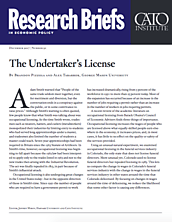Adam Smith warned that “People of the same trade seldom meet together, even for merriment and diversion, but the conversation ends in a conspiracy against the public, or in some contrivance to raise prices.” Although Smith’s warning is often quoted, few people know that what Smith was talking about was occupational licensing. At the time Smith wrote, tradesmen such as weavers, hatters, and cutlers (metalworkers) monopolized their industries by limiting entry to students who had served long apprenticeships under a master, and tradesmen also limited the number of students a master could teach. Seven-year apprenticeships had been required in Britain since the 1563 Statute of Artificers. In Smith’s time, however, occupational licensing was beginning to fall apart because the 1563 law had been interpreted to apply only to the trades listed in 1563 and not to the new trades then arising with the Industrial Revolution. The act was finally repealed in 1813, in part because of Smith’s influential attack.
Occupational licensing is also undergoing great changes in the United States today—but in the opposite direction of those in Smith’s time. Since 1950 the number of people who are required to have a government permit to work has increased dramatically, rising from 5 percent of the workforce in 1950 to more than 25 percent today. Most of the expansion has occurred because of an increase in the number of jobs requiring a permit rather than an increase in the number of workers in jobs requiring permits. A recent review of the academic literature on occupational licensing from Barack Obama’s Council of Economic Advisers finds three things of importance. Occupational licensing increases the wages of people who are licensed above what equally skilled people earn elsewhere in the economy; it increases prices; and, in most cases, it has little to no effect on the quality or safety of the services provided.
Using an unusual natural experiment, we examined occupational licensing in the funeral services industry in Colorado, the only state that does not license funeral directors. More unusual yet, Colorado used to license funeral directors but repealed licensing in 1983. This lets us compare the change in wages in Colorado’s funeral services industry with the change in wages in the funeral services industry in other states around the time that Colorado delicensed. By focusing on changes in wages around the time of delicensing, we reduce the likelihood that some other factor is causing any differences.
Before 1983, wages in the funeral services industry in Colorado and the rest of the United States were at a similar level and, most importantly, had parallel trends. After 1983, wages in the funeral services industry in Colorado grew more slowly than those in the rest of the United States until about 1990, when the trends started to move in parallel once again. Thus, it appears that delicensing reduced wages in Colorado’s funeral services industry and the effect took about seven years to work its way through the industry (perhaps because it is difficult to reduce wages for current employees but easier to hire new people at lower wages). At the end of the seven years, wages in Colorado’s funeral services industry were about 11 percent lower than those in the rest of the United States.
Examining changes in wages around the time of delicensing reduces, but does not eliminate, the possibility that other factors are responsible for the changes in wages. It’s possible, for example, that some other factor reduced wages in Colorado and that this factor just happened to occur in 1983 coincident with delicensing. To address this possibility, we look at the changes in wages in Colorado’s funeral services industry relative to wages in other industries in Colorado and compared this difference to the same difference elsewhere in the United States. The results are consistent with our first test: we find that delicensing reduced wages in Colorado’s funeral services industry by 11 percent.
In a third test, we compared wages in Colorado not to the rest of the United States but to a specially created “doppelganger” Colorado, a Colorado created from parts of other states designed to look statistically as similar to Colorado as possible. Using this “synthetic control technique,” we find that delicensing reduces wages by 8–19 percent, a wider range than with the previous tests but consistent with a wage reduction of about 11 percent.
We also have some data on prices in the funeral services industry and they show, perhaps not surprisingly, that prices fall with delicensing (i.e., that licensing increases prices). One surprise, however, is that the effect on prices is larger than the effect on wages—nearly a 15 percent decline. Because wages are only one factor in costs, this disparity suggests that delicensing does more than lower wages. That’s plausible because earlier research by economists David Harrington and Kathy Krynski found that funeral directors who, as part of their license, are required to be embalmers seem to push consumers toward more expensive burial procedures rather than cremation. We also test for this effect in Colorado and find that cremation rates increased in Colorado relative to the rest of the United States after delicensing.
NOTE:
This research brief is based on Brandon Pizzola and Alexander Tabarrok, “Occupational Licensing Causes a Wage Premium: Evidence from a Natural Experiment in Colorado’s Funeral Services Industry,” International Review of Law and Economics 50 (2017): 50–59.
About the Authors

This work is licensed under a Creative Commons Attribution-NonCommercial-ShareAlike 4.0 International License.
